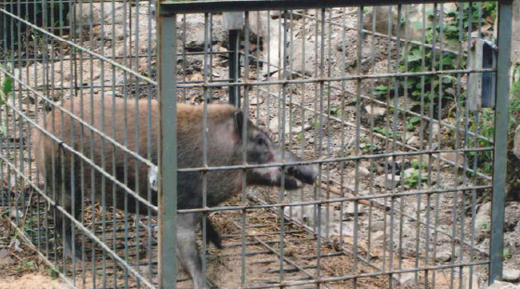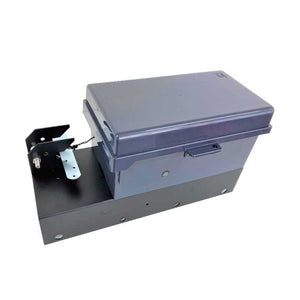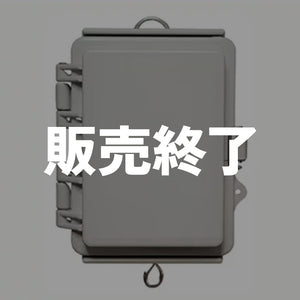Bait is used to lure the wild boar into the cage box, and when the prey enters the box, the door closes with a "Gashan!" Box traps are the royal road for catching wild boars. This article explains how to set up and patrol box traps.
If you have prepared a box trap, but don't know what to do after that, or if you just can't catch it, please use it as a reference.
About setting up box traps
Selection of installation location
Decide on a location before installation. Depending on where you put it, the catch rate will change greatly.
Also, once a box trap is installed, it is difficult to move, so choosing the installation location is very important. If the box trap is unstable, animals that try to enter the box trap for food will be alarmed.
Also, if the box trap is tilted, the trap will not work properly. As for the installation location, choose a flat place where it will not wobble as much as possible. Also, if you find an animal trail and there is mud on the leaves around it, it is likely that there is a Nutaba (a place where wild boars bathe) nearby.
It is also a good idea to place box traps in places where there are many traces of wild boars, such as footprints, droppings, and food marks.
One-point advice for installation
If a wild boar feels uncomfortable with the scaffolding, it will avoid that part. However, due to the structure of the box trap, the scaffolding is uneven due to the cage on the floor, and it is full of discomfort from the point of view of the wild boar.
Therefore, the metal on the floor of the box trap is covered with soil so that it cannot be seen. It is also a good idea to cover the steps at the entrance of the trap with soil as much as possible so that the ground continues from the entrance to the inside of the trap in a natural way.
Reference article : How to set a box trap
After installation is complete, a sign stating the address, name, permitter, permit date, permit number, purpose of capture, permit expiration date (hunter registration year, registration number, etc. in the case of hunting) is attached to the body of the trap. However, clearly state that you have permission to capture harmful birds and beasts and that you have registered as a hunter.
Also, to prevent the general public from accidentally approaching the box trap, set up a signboard to inform the surroundings of the trap setting.
Patrol after installation
Once the box trap is set up, the boars are lured to the trap by baiting it, but it is important not to leave it as it is after baiting, but to look around it at regular intervals. Be sure to look around once a day.
Juveniles (gourds) are less cautious, so they will enter the inside of the box trap relatively soon to eat food. On the other hand, it takes time for an adult animal to enter a box trap. Even if the juveniles are leisurely eating food inside the trap, the adults on the side are wary of the front of the trap and do not try to enter the back.
Therefore, it is necessary to feed them enough to catch adults, and to relieve their guard against box traps.
Sprinkle bait on the outside of the box trap first and observe how the bait bites. By looking at the traces of being eaten during patrols, it predicts the beast's movements and gradually changes the way it scatters bait to lure it into the trap.
Before the boar gets all the way into the box trap, you need to keep the door from falling down. This is because if the door is dropped before the vigilance is fully released and the adult is lost, the individual becomes very wary of the box trap, making it difficult to capture.
If you use a trail camera, you can observe the surroundings of the box trap in an unmanned state, and you can grasp the movement of the beast, so it is recommended. >> About trail cameras.
In addition, when making patrols, we bring replacement bait, shovels, kick strings and parts for replacement and maintenance.
if prey was at stake
When making patrols, if you find that prey is on the hook from a distance, don't approach it suddenly to check, but first check the situation from a distance.
Visually check how excited the beast is, whether it is weakened, whether the box trap is damaged, and whether the beast is likely to escape. If the movement of the beast inside the trap is difficult to understand, it is a good idea to deliberately make some noise and see how it reacts.
The most troublesome part is the timing of the stabbing. Before you get used to it, act with multiple people as much as possible and deal with it without overdoing it. If you want to stop the stabbing as it is, use a retainer to restrain the legs and nose to limit the movement of the captured animal, making it easier to stop the stabbing.
In addition, you can limit the area in which the beast can move inside the trap by inserting a square timber or the like through the gaps in the net of the box trap.
Reference article : About stopping captured animals (wild boars, deer, etc.)
If you're going to use a gun for the stabbing, check in advance to see if the area allows stabbing with a gun. Also, if you have caught an animal by mistake (capturing an animal that is not intended for capture), please release the animal immediately.
Example of box trap installation
Finally, I will introduce an example of setting a box trap handled by Inohoi . The box trap in the video below has been set up for many years, but I can catch several per year without changing the location. There are many animal trails nearby, and there are also traces of what seems to have been a slaughterhouse.
The type of food is currently rice, sweet potato, and sometimes corn. Other bait may be used.
The staff patrols every day, but somehow this place is often caught. When I took this photo, I didn't see any bites of the bait.
The kick string uses a black string to make it difficult to see from the beast. I put a branch in the trap and devised a way to set the kick string so that the trap will be activated just by touching the branch. If you want to see the same product, please visit this page.

 箱罠
箱罠
 くくり罠
くくり罠
 パーツ類
パーツ類
 電気柵
電気柵
 自作キット
自作キット
 防獣グッズ
防獣グッズ
 監視カメラ
監視カメラ

![[Explanation step-by-step] From catching wild boars by tying traps to catching them alive](http://inohoi.jp/cdn/shop/articles/inoshishi_1_-min_520x500_520x500_520x500_520x500_4420c9dd-b9d3-4280-ac59-33eb8c1d1501.jpg?v=1759380216&width=750)





 box trap
box trap
 tying trap
tying trap
 enclosure trap
enclosure trap
 Prevention and avoidance goods
Prevention and avoidance goods
 electric fence
electric fence
 trap surveillance camera
trap surveillance camera
 transportation goods
transportation goods
 Trap detection sensor
Trap detection sensor
 hunting supplies
hunting supplies
 hunting books
hunting books
 Anti-bird goods
Anti-bird goods
 Agricultural materials/machinery
Agricultural materials/machinery
 boar
boar
 deer
deer
 Kyon
Kyon
 monkey
monkey
 raccoon
raccoon
 Badger
Badger
 palm civet
palm civet
 raccoon dog
raccoon dog
 nutria
nutria
 mouse or rat
mouse or rat
 Mole
Mole
 bear
bear
 pigeon
pigeon
 Crow
Crow







